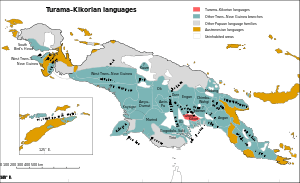Turama–Kikorian languages
The Turama–Kikorian languages are a family identified by Arthur Capell (1962) and part of the Trans–New Guinea languages (TNG) family in the classifications of Stephen Wurm (1975) and Malcolm Ross (2005). The family is named after the Turama River and Kikori River of southern Papua New Guinea; the alternative name is based more narrowly on the Omati River.
| Turama–Kikorian | |
|---|---|
| Rumu – Omati River | |
| Geographic distribution | Omati River region, Gulf Province, Papua New Guinea |
| Linguistic classification | Papuan Gulf ?
|
| Subdivisions |
|
| Glottolog | tura1263[1] |
 Map: The Turama–Kikorian languages of New Guinea
The Turama–Kikorian languages
Trans–New Guinea languages
Other Papuan languages
Austronesian languages
Uninhabited | |
Languages
The four languages are clearly related, though Rumu is divergent. Ross states that Rumu links the other (Turama) languages to TNG.
Fauna names
Below are some turtle names, with additional names in Porome, Kiwaian, and Kutubuan languages also provided for comparison:[2]
| Language [Location] | Emydura subglobosa | Elseya novaeguineae | Carettochelys insculpta | Pelochelys bibroni | Marine turtle |
|---|---|---|---|---|---|
| Ikobi [Kasere] (Kaiam) | Kaso bubal | Kaso bubal | Kaso Uwo | Kaso Mimiri | – |
| Foroba (Omo, Kuru) | Kinisuga | Kesoga | Buguama | Mimiri | – |
| Rumu (Kopi, Ogamabu, Irimuku, Lalau, Ario, Waira) | Kehoko | Kehoko, Purapati | Piku | Mimiri, Otohehe | – |
| Porome [Kibiri] (Veiru, Doibo) | Ketori | Ketori | Watemui | Kauri | – |
| Porome [Porome] (Ero, Wowou) | Ketoko | Ketoko | Watemu | Dabeuri | – |
| Kerewo [Goaribari] (Apeawa, Samoa) | – | Koimo[3] | Uwo[4] | Unawaya | Mirimiri, Gamo[5] |
| Kiwai, Northeast [Urama] (Veraibari) | Koimo | Koimo | Va’ema[6] | Goava’ema | Mia Mia |
| Foi (Soro, Wasami, Tugiri, Kese, Kapoi) | – | Baregwarabo | – | – | – |
| Fasu (Wairo, Hebaya) | – | Eketaiyaa | – | – | – |
Names for Emydura subglobosa and Elseya novaeguineae are generally identical or similar.
See also: Yam languages#Fauna names.
gollark: The English interpreter is too computationally expensive.
gollark: It's a comment.
gollark: ```x86asm!PAD E0LOOP:re 8 RI # read target location from arbitrary side into bufferadd RJ RI !1mez RJ I !0 # if target location is 255, jump to 0 (normal thing start)re 8 RJ # read data into other bufferidm RI RJ # transfer data into specified locationmov I !LOOP # unconditional jump back to startRI: ! 0RJ: ! 0```Here is the bootloader code, loaded onto all new nodes by default to allow self-replication.
gollark: This means I can use the elegant MEZ and MNZ for flow control.
gollark: osmarksISA™-12847 has variable width instructions, arbitrary arithmetic stuff built in, no concept of immediate operands, and the program counter mapped in at location 0xFF in memory.
References
- Hammarström, Harald; Forkel, Robert; Haspelmath, Martin, eds. (2017). "Turama–Kikori". Glottolog 3.0. Jena, Germany: Max Planck Institute for the Science of Human History.
- Georges, A., Guarino, F., & Bito, B. (2006). Freshwater turtles of the TransFly region of Papua New Guinea – notes on diversity, distribution, reproduction, harvest and trade. Wildlife Research, 33(5), 373. doi:10.1071/wr05087
- Confirmed for Samoa Village, Aird Hills by Martin Steer.
- Confirmed for Samoa Village, Aird Hills by Martin Steer.
- Name provided by Martin Steer for Samoa Village (Kerewo), Aird Hills.
- Ma’ema has been recorded for Gope dialect, Kiwai NE language by Robert Petterson.
- Ross, Malcolm (2005). "Pronouns as a preliminary diagnostic for grouping Papuan languages". In Andrew Pawley; Robert Attenborough; Robin Hide; Jack Golson (eds.). Papuan pasts: cultural, linguistic and biological histories of Papuan-speaking peoples. Canberra: Pacific Linguistics. pp. 15–66. ISBN 0858835622. OCLC 67292782.
External links
- Timothy Usher, New Guinea World, Proto–Rumu – Omati River
- (ibid.) Proto–Omati River
This article is issued from Wikipedia. The text is licensed under Creative Commons - Attribution - Sharealike. Additional terms may apply for the media files.